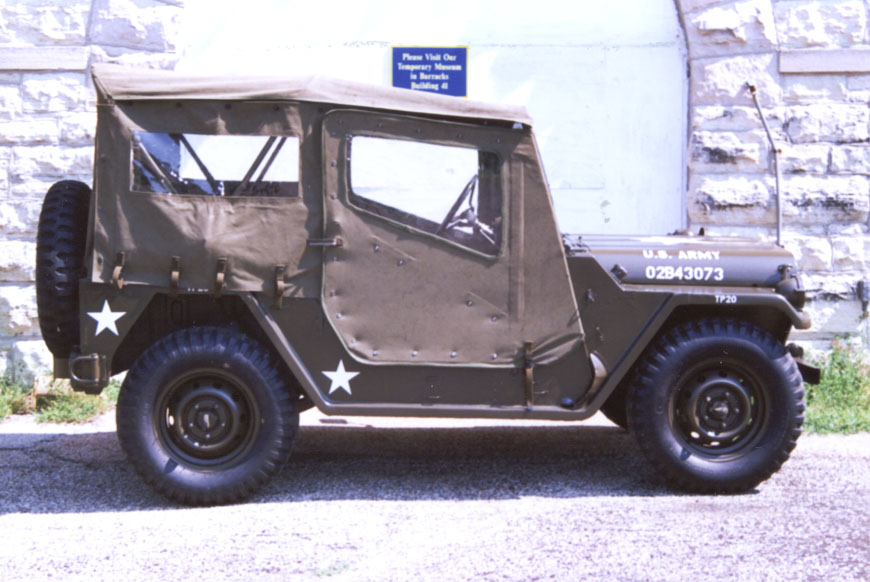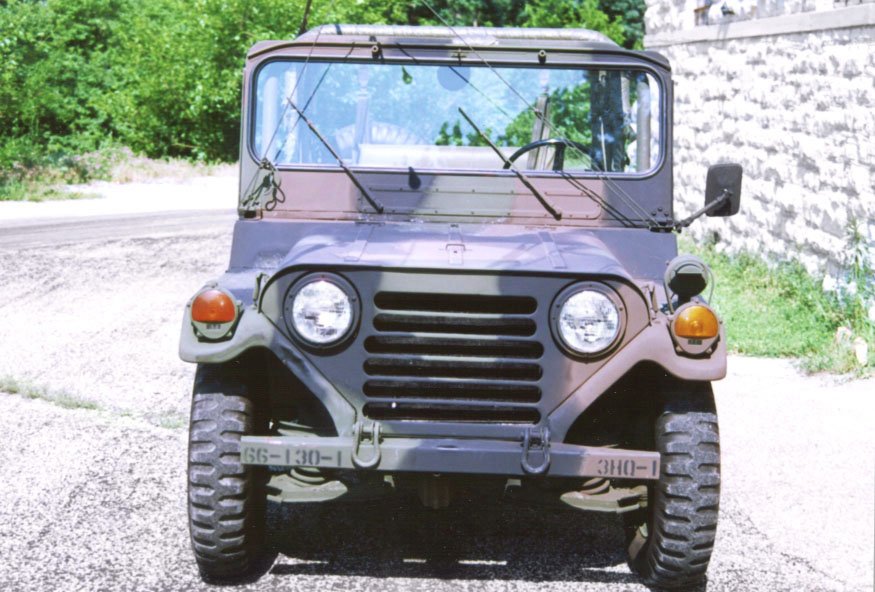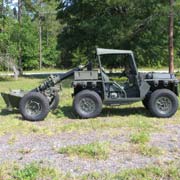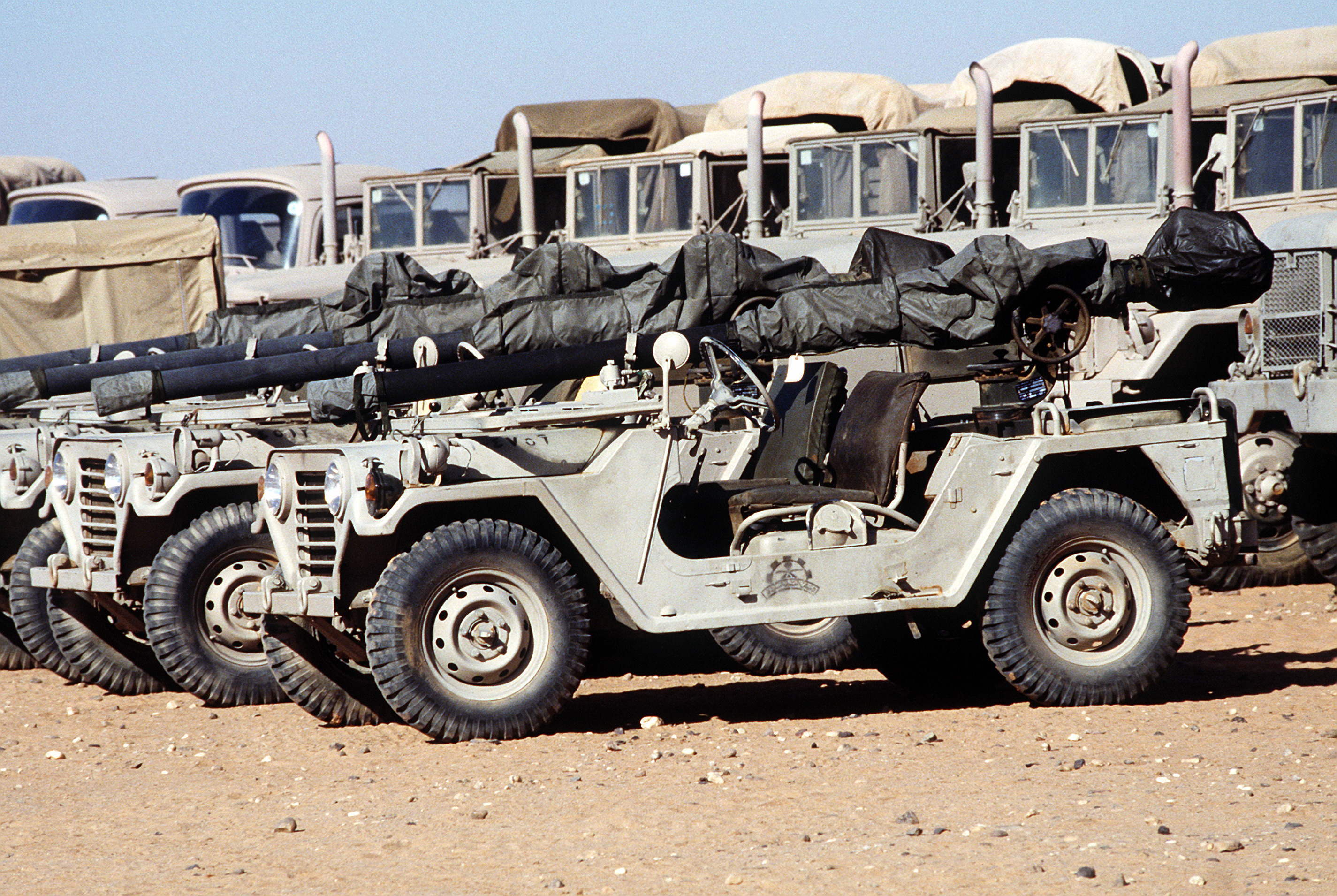M151 ¼-ton 4×4 utility truck on:
[Wikipedia]
[Google]
[Amazon]
The Truck, Utility, ¼-Ton, 4×4, M151 or simply M151 was the successor to the Korean War M38 and M38A1
 Although the M151 mostly retained the same basic layout and dimensions of its predecessors, it was for all intents and purposes a completely new design. Unlike previous jeep designs, whose structure consisted of a steel tub bolted onto a separate steel frame, the M151 utilized an integrated frame design, which integrated the box frame rails and the sheet-steel body into a
Although the M151 mostly retained the same basic layout and dimensions of its predecessors, it was for all intents and purposes a completely new design. Unlike previous jeep designs, whose structure consisted of a steel tub bolted onto a separate steel frame, the M151 utilized an integrated frame design, which integrated the box frame rails and the sheet-steel body into a  Another area improved upon in the M151 was the suspension. Dispensing with the rigid
Another area improved upon in the M151 was the suspension. Dispensing with the rigid
 First put into service in the early 1960s, the M151 played an active part in American military operations well into the 1980s, when it was phased out in favor of the
First put into service in the early 1960s, the M151 played an active part in American military operations well into the 1980s, when it was phased out in favor of the
 Growler Manufacturing and Engineering designs and sells the Internally Transportable Light Strike Vehicle based on the M151 drivetrain. The Internally Transportable Light Strike Vehicle is intended to replace Fast Attack Vehicle variants of the M151, and is reduced in size to fit into the
Growler Manufacturing and Engineering designs and sells the Internally Transportable Light Strike Vehicle based on the M151 drivetrain. The Internally Transportable Light Strike Vehicle is intended to replace Fast Attack Vehicle variants of the M151, and is reduced in size to fit into the
It got the nickname of "Air Force FAV" from a famous picture of U.S. Air Force Maj. Gen. William S. Hinton Jr., commander of Joint Task Force Shining Hope, getting out of one.

 *
*
*
*
*
*
*
*
*
*
*
*
*
*
*
*
*
*
*
*
*
*
*
*
*
*
*
*
*
*
*
*
*
*
*
*
*
*
*
*
*
*
*
*
*
*
*
*
*
*
*
*
*
*
*
*
*
*
*
*
*
*
*
*
*
*
*
*
*
*
*
*
*
*
*
*
*
*
*
*
*
*
*
*
*
*
*
*
*
*
*
*
*
*
*
*
*
*
*
*
*
*
*
*
*
*
*
*
*
*
*
*
*
*
*
*
*
*
 *
*
M151 series at Olive-Drab.com
* * {{DEFAULTSORT:M151 Military trucks of the United States Ford vehicles Military light utility vehicles Military vehicles introduced in the 1960s
jeep
Jeep is an American automobile marque, now owned by multi-national corporation Stellantis. Jeep has been part of Chrysler since 1987, when Chrysler acquired the Jeep brand, along with remaining assets, from its previous owner American Motors ...
Light Utility Vehicles. The M151 had an integrated body design which offered a little more space than prior jeeps, and featured all-around independent suspension
Independent suspension is any automobile suspension system that allows each wheel on the same axle to move vertically (i.e. reacting to a bump on the road) independently of the others. This is contrasted with a beam axle or deDion axle system ...
with coil springs. It has since been replaced by the larger AM General HMMWV in most utility roles in frontline use. With some M151A2 units still in U.S. military service in 1999, the M151 series achieved a longer run of service than that of the World War II/Korean War-era MB/GPW, M38, and M38A1 series combined.
History
In 1951Ford Motor Company
Ford Motor Company (commonly known as Ford) is an American multinational automobile manufacturer headquartered in Dearborn, Michigan, United States. It was founded by Henry Ford and incorporated on June 16, 1903. The company sells automobi ...
was awarded the contract to design a ¼-ton 4×4 truck to replace the aging M38 and M38A1 model jeeps. The M151 was developed to specifications and guidance of the U.S. Army's Ordnance Tank Automotive Command. Design started in 1951 and testing and prototyping lasted through most of the fifties. Although the M151 was developed and initially produced by Ford, production contracts for the M151A2 were later also awarded to Kaiser
''Kaiser'' is the German word for "emperor" (female Kaiserin). In general, the German title in principle applies to rulers anywhere in the world above the rank of king (''König''). In English, the (untranslated) word ''Kaiser'' is mainly ap ...
and AM General Corp, a subsidiary of AMC.
Design
 Although the M151 mostly retained the same basic layout and dimensions of its predecessors, it was for all intents and purposes a completely new design. Unlike previous jeep designs, whose structure consisted of a steel tub bolted onto a separate steel frame, the M151 utilized an integrated frame design, which integrated the box frame rails and the sheet-steel body into a
Although the M151 mostly retained the same basic layout and dimensions of its predecessors, it was for all intents and purposes a completely new design. Unlike previous jeep designs, whose structure consisted of a steel tub bolted onto a separate steel frame, the M151 utilized an integrated frame design, which integrated the box frame rails and the sheet-steel body into a unibody
A vehicle frame, also historically known as its '' chassis'', is the main supporting structure of a motor vehicle to which all other components are attached, comparable to the skeleton of an organism.
Until the 1930s, virtually every car ha ...
structure. Eliminating the separate frame gave the M151 slightly more ground clearance, while at the same time lowering the center of gravity. Although the vehicle's dimensions were only slightly enlarged — the 85 inch wheelbase was 4 inches longer than its predecessor, or 5 inches compared to the Willys MB
The Willys MB and the Ford GPW, both formally called the U.S. Army Truck, -ton, 4×4, Command Reconnaissance, commonly known as the Willys Jeep, Jeep, or jeep, and sometimes referred to by its supply catalogue designation G503,According to i ...
, and the width was increased 3 inches — combined with the improved space efficiency of the integrated body design, the vehicle was a bit roomier than previous jeeps, while retaining the same light weight.
 Another area improved upon in the M151 was the suspension. Dispensing with the rigid
Another area improved upon in the M151 was the suspension. Dispensing with the rigid live axle
A beam axle, rigid axle or solid axle is a dependent suspension design in which a set of wheels is connected laterally by a single beam or shaft. Beam axles were once commonly used at the rear wheels of a vehicle, but historically they have als ...
s in the front and rear that all previous military jeeps used (a layout still used on modern day Jeeps, such as the Jeep CJ
The Jeep CJ models are a series and a range of small, open-bodied off-road vehicles and compact pickup trucks, built and sold by several successive incarnations of the Jeep automobile marque from 1945 to 1986. The 1945 Willys Jeep was the world ...
and Wrangler), the M151 was instead equipped with independent suspension
Independent suspension is any automobile suspension system that allows each wheel on the same axle to move vertically (i.e. reacting to a bump on the road) independently of the others. This is contrasted with a beam axle or deDion axle system ...
and coil springs. This made it capable of high-speed, cross-country travel, while boasting high maneuverability and agility. The new suspension also had the added benefit of providing a more comfortable ride.
Due to copyright and trademark issues, the M151 did not feature Jeep's distinctive seven vertical slot grille, instead, a horizontal grille was used.
Handling problems
Unlike other military transports, such as the WWII and Korean War-eraJeeps
Jeep is an American automobile marque, now owned by multi-national corporation Stellantis. Jeep has been part of Chrysler since 1987, when Chrysler acquired the Jeep brand, along with remaining assets, from its previous owner American Motor ...
and Dodge and Chevrolet transport trucks, the M151 was never widely released into the civilian market. This was partly because it did not meet federal highway safety standards for civilian vehicles, and because of a series of rollover accidents. While the high pivot rear swing axle
A swing axle is a simple type of independent (rear wheel) suspension designed and patented by Edmund Rumpler in 1903. This was a revolutionary invention in automotive suspension, allowing driven (powered) wheels to follow uneven road surfaces ...
geometry on the M151A1 was responsible for the rollovers, injuries and fatalities, the industry (Ford and the Army) claimed that they were primarily due to driver errors, with operators unprepared for the increased performance compared to the Jeeps, which it replaced. The swing axle rear design was prone to significant camber changes when subjected to cornering, resulting in the rear lifting, the inside wheel tucking under which often led to a vehicle rollover. Steering input as commonly found in a high-speed emergency avoidance maneuvers or hard cornering, was a recipe for disaster. The vehicle's tendency to lose control was reduced when there was weight in the rear, so drivers would often place an ammunition box filled with sand under the rear seat when no other load was being carried. The box could simply be emptied or abandoned when the extra weight was not needed. Recoilless rifle
A recoilless rifle, recoilless launcher or recoilless gun, sometimes abbreviated "RR" or "RCL" (for ReCoilLess) is a type of lightweight artillery system or man-portable launcher that is designed to eject some form of countermass such as propel ...
carrier models were especially prone to rollover accidents due to their stiffer rear springs and were typically subjected to severe speed restrictions any time the gun was not aboard.
Ford Motor Company designed the M151A1 beginning in 1951. By 1965 the world knew of the problems with swing axles (e.g. ''Unsafe at Any Speed
''Unsafe at Any Speed: The Designed-In Dangers of the American Automobile'' is a non-fiction book by consumer advocate Ralph Nader, first published in 1965. Its central theme is that car manufacturers resisted the introduction of safety features ( ...
'' by Ralph Nader). Nevertheless, when, in 1969, an automotive engineer at the Human Engineering Lab at Aberdeen Proving Ground wrote a report that included: 1) an analysis that showed the high pivot swing axle in the M151A1 was inherently unstable under cornering, 2) retrofits that had proven to solve the problem on Corvairs, VWs, and Formula Vees and, 3) ways of designing a replacement. The Director of the Human Engineering Lab rejected this report and when the solutions were forwarded to the Ford engineers they rejected them as well.
The handling issues were eventually resolved by a redesign of the rear suspension, introduced in the M151A2 model. However, due to liability concerns, the U.S. Department of Defense deemed all M151 series vehicles "unsafe for public highway use", limiting their public use. Continuing problems with vehicle roll-overs into the 1980s led the U.S. military to retrofit many M151 series vehicles with the " Roll over protection structure" (ROPS), a roll cage intended to protect both front and rear seat passengers.
Service
HMMWV
The High Mobility Multipurpose Wheeled Vehicle (HMMWV; colloquial: Humvee) is a family of light, four-wheel drive, military trucks and utility vehicles produced by AM General. It has largely supplanted the roles previously performed by the ori ...
. Despite its official replacement, the M151 had some distinct advantages over its much larger and heavier successor, like being small enough to fit inside a CH-53 heavy transport helicopter.
Various models of the M-151 have seen successful military service in 15 different NATO
The North Atlantic Treaty Organization (NATO, ; french: Organisation du traité de l'Atlantique nord, ), also called the North Atlantic Alliance, is an intergovernmental military alliance between 30 member states – 28 European and two N ...
countries and M151s were sold to many countries, including Canada, Denmark, the United Kingdom and non-NATO countries like Egypt, Lebanon, Israel, the Philippines, and Pakistan. Currently, the M151 is used by over 100 countries worldwide.
Post-military use
In the late 1980s the M151s began being phased out of service in favour of the HMMWV. A few (perhaps 1,000) were sold via Government Surplus auctions, and those that were not sold viaForeign Military Sales
The United States Department of Defense's Foreign Military Sales (FMS) program facilitates sales of U.S. arms, defense equipment, defense services, and military training to foreign governments. The purchaser does not deal directly with the defense ...
(FMS) overseas were cut into four pieces and scrapped. However some individuals were able to buy these "quartered" M151s and simply weld the four sections back together, and rebuilt them into drivable condition. Some vehicles sold in the United States were simply cut in half, some of which were simply welded back together and driven. Additionally, beginning in the late 1990s a few companies dealing in Military surplus items bought M151s from some of the foreign governments that received the vehicles via FMS for reconditioning and further sales.
The Growler
 Growler Manufacturing and Engineering designs and sells the Internally Transportable Light Strike Vehicle based on the M151 drivetrain. The Internally Transportable Light Strike Vehicle is intended to replace Fast Attack Vehicle variants of the M151, and is reduced in size to fit into the
Growler Manufacturing and Engineering designs and sells the Internally Transportable Light Strike Vehicle based on the M151 drivetrain. The Internally Transportable Light Strike Vehicle is intended to replace Fast Attack Vehicle variants of the M151, and is reduced in size to fit into the V-22 Osprey
The Bell Boeing V-22 Osprey is an American multi-mission, tiltrotor military aircraft with both vertical takeoff and landing (VTOL) and short takeoff and landing (STOL) capabilities. It is designed to combine the functionality of a conventio ...
tiltrotor transport. Although originally intended to utilize the M151 drivetrain, the result is an all new design and contains no M151 parts or design elements.
Variants
* M151 (1960) – Original, standard version of the clean-sheet, Ford designed, all new jeep. Because of its simpleindependent rear suspension
Independent suspension is any automobile suspension system that allows each wheel on the same axle to move vertically (i.e. reacting to a bump on the road) independently of the others. This is contrasted with a beam axle or deDion axle system i ...
, it had a dangerous tendency to flip over when cornered too aggressively by unaware drivers. The cheap swing-axle rear suspension design (like that of the original VW Beetle
The Volkswagen Beetle—officially the Volkswagen Type 1, informally in German (meaning "beetle"), in parts of the English-speaking world the Bug, and known by many other nicknames in other languages—is a two-door, rear-engine economy car, ...
and Chevrolet Corvair
The Chevrolet Corvair is a compact car manufactured by Chevrolet for model years 1960–1969 in two generations. A response to the Volkswagen Beetle, it remains the only American-designed, mass-produced passenger car with a Rear-engine design, ...
), would result in large rear-wheel camber angle
Camber angle is one of the angles made by the wheels of a vehicle; specifically, it is the angle between the vertical axis of a wheel and the vertical axis of the vehicle when viewed from the front or rear. It is used in the design of steering a ...
changes, and could cause drastic oversteer
Understeer and oversteer are vehicle dynamics terms used to describe the sensitivity of a vehicle to steering. Oversteer is what occurs when a car turns (steers) by more than the amount commanded by the driver. Conversely, understeer is what occ ...
and a subsequent roll-over.
* M151A1 (1964) – Second version: minor changes in the rear suspension, mostly aimed at allowing the vehicle to carry heavier loads. Addition of turn signals to front fenders. The essentials of the rear suspension remained unchanged and the same applies to the handling problems in corners.
** M151A1C – The M151A1C equipped with a 106 mm recoilless rifle on a pedestal-mount. Capable of carrying six rounds of ammunition and weapon tools. Including the driver, it provides space for two men and has a cruising range of 442 km or 275 miles.
** M151A1D – Tactical nuclear variant. This was an M151A1C modified to mount the Davy Crockett Atomic Warhead Launcher (in parallel development with a similarly equipped M38A1 and other tactical vehicles).
** M718 – Front-line ambulance variant with an extended rear body to enable the transport of wounded patients on litters. Crewed by two — a driver and a medic, it could carry three litters. Notably, although the M718 is larger than an M151 in all three dimensions – its greater length, width and height resulted from only minimal changes to the standard M151 design — retaining both the same wheelbase
In both road and rail vehicles, the wheelbase is the horizontal distance between the centers of the front and rear wheels. For road vehicles with more than two axles (e.g. some trucks), the wheelbase is the distance between the steering (fron ...
and track width
In automobiles (and other wheeled vehicles which have two wheels on an axle), the axle track is the distance between the hub flanges on an axle. Wheel track, track width or simply track refers to the distance between the centerline of two wheels o ...
unchanged. The spare wheel was moved from the rear to the side, to allow the rear body extensions, but also resulting in the increase in width. The ambulance "body" of the M718 consisted mostly just of taller bows, and a longer, taller, canvas top. The changes to the body and chassis, compared to the base M151 were remarkably minimal, considering its predecessor, the M170 jeep ambulance, had received a full wheelbase stretch from the base M38A1 jeep.
* M151A2 (1968) – The A2 fielded a significantly revised rear suspension that greatly improved safety in fast cornering. The M151 now had Semi-trailing arm suspension
A (semi) trailing-arm suspension, sometimes referred to as (semi) trailing-link is a vehicle axle or wheel suspension design in which one or more horizontal arms (or "links"), perpendicular to and forward of the axle, are connecting the axle or w ...
. Many smaller upgrades including improved turn signals. The A2 can be identified by the large combination turn signal/blackout lights on the front fenders, which also had been modified to mount the larger lights, as opposed to earlier A1's that had flat front fenders.
** M151A2 TOW – tube-launched, optically tracked, wire-guided (TOW) anti-tank missile variant.
** M718A1 – Front-line ambulance variant that featured an extended rear body to allow the transport of litters.
** M825 – Variant with M40 106 mm recoilless rifle mounted on rear. It had racks in the cargo bed to carry 4 shells.
** M1051 – Firefighting variant which saw exclusive use by the Marine Corps.
** MRC108 – Forward Air Control variant, with multi-band communications equipment.
* Fast Attack Vehicles
** M151A2 FAV – Fast Assault Vehicle variant designed to be carried inside a CH-53 helicopter. Modification mainly involves adding a combination radiator grille armor plate and spare tire carrier, a field radio bracket between the front seats, roll bars or roll-cage, and high-beam lights. It has a heavy weapons pedestal mount post mounted on the rear deck (capable of carrying a Browning M2HB, Mark 19 Automatic Grenade Launcher or TOW II Missile). The rear bustles had brackets to mount large storage baskets and the front bustles had brackets to mount small storage baskets for fuel jerry cans or single ammo boxes.
** Marine FAV Mk I "Super Jeep": Fast Attack Vehicle. Models originally had a flat black paint job and a velcro-fastened cloth "blackout panel" that covered the dashboard gauges. The front-mounted roll bar, which replaced the front folding windshield, was made from threaded heavy-gauge pipe.
** Marine FAV Mk II: Fast Attack Vehicle. Models originally had a MERDC "woodland" camouflage paint job and a welded roll-bar that was reinforced with two angled support braces of heavy-gauge welded pipe between the front seats. Had two high-beam lights mounted under the top of the rollbar. Highly customized by the units converting it, leading to numerous unique modifications.
** Airborne
Airborne or Airborn may refer to:
Arts, entertainment, and media
Films
* ''Airborne'' (1962 film), a 1962 American film directed by James Landis
* ''Airborne'' (1993 film), a comedy–drama film
* ''Airborne'' (1998 film), an action film sta ...
FAV (AKA Ranger FAV): Fast Attack Vehicle. Has a forward-facing M60 GPMG or M240 MAG GPMG in a M32 45° weapons mount welded to the dashboard on the front passenger side, a horizontal storage box containing an AT-4 Anti-Tank Rocket, and a vertical storage rack behind the front seats that holds 8 to 10 M72 LAW
The M72 LAW (light anti-tank weapon, also referred to as the light anti-armor weapon or LAW as well as LAWS: light anti-armor weapons system) is a portable one-shot unguided anti-tank weapon. The solid rocket propulsion unit was developed in t ...
Rockets. The rear bustles can mount locker baskets that can each contain 4 × M2/M2A1 ammo boxes for the main gun and the front bustles can contain single ammo boxes for the M60.
** Air Force FAV: Has a roll cage and a 360° ring mount over the rear seat. This model was designed by Marine Sgt. David Ferry and saw service with the MEUs and other Special Operations units. It got the nickname of "Air Force FAV" from a famous picture of U.S. Air Force Maj. Gen. William S. Hinton Jr., commander of Joint Task Force Shining Hope, getting out of one.
Users

See also
 *
* FMC XR311
The XR311 was a prototype military vehicle of US origin that was procured in limited numbers during the 1970s. It was originally developed as the ''High Mobility Combat Vehicle'', or HMCV (not to be confused with the JGSDF MCV, which was also c ...
* G-numbers
This is the Group G series List of the United States military vehicles by (Ordnance) supply catalog designation, — ''one'' of the alpha-numeric "Standard Nomenclature Lists" (SNL) that were part of the overall List of the United States Army w ...
* M416 trailer
The Jeep trailer was a small, payload rated, cargo trailer, designed in World War II, tailored to be towed by 1/4-ton U.S. Army jeeps. Versions of the quarter-ton jeep trailer remained in military use, by the U.S. or other countries, at least t ...
* Willys FAMAE Corvo
The Willys FAMAE Corvo was an off-road multipurpose vehicle intended for use with the Chilean Armed Forces. Its chassis was originally from a Willys MB and was capable of carrying various types of mounted weapons such as a 106mm recoilless anti-ta ...
* Austin Champ
The Austin Champ was a military and civilian jeep-like vehicle made by the Austin Motor Company in the 1950s. The army version was officially known as "Truck, 1/4 ton, CT, 4×4, Cargo & FFW, Austin Mk.1" however the civilian name "Champ" was un ...
* UAZ-469
Notes
References
* * * * * * * * * * * * U.S Army Ordnance Corps Supply Catalog G838External links
M151 series at Olive-Drab.com
* * {{DEFAULTSORT:M151 Military trucks of the United States Ford vehicles Military light utility vehicles Military vehicles introduced in the 1960s